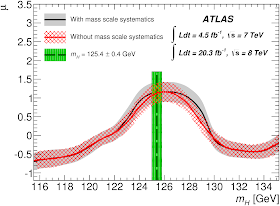This weekend's plot is the latest ATLAS measurement of the Higgs signal strength μ in the diphoton channel:
Together with the CMS paper posted earlier this summer, this is probably the final word on Higgs-to-2-photons decays in the LHC run-I. These measurements have had an eventful history. The diphoton final state was one of the Higgs discovery channels back in 2012. Initially, both ATLAS and CMS were seeing a large excess of the Higgs signal strength compared to the standard model prediction. That was very exciting, as it was hinting at new charged particles with masses near 100 GeV. But in nature, sooner or later, everything has to converge to the standard model. ATLAS and CMS chose different strategies to get there. In CMS, the central value μ(t) displays an oscillatory behavior, alternating between excess and deficit. Each iteration brings it closer to the standard model limit μ = 1, with the latest reported value of μ= 1.14 ± 0.26. In ATLAS, on the other hand, μ(t) decreases monotonically, from μ = 1.8 ± 0.5 in summer 2012 down to μ = 1.17 ± 0.27 today (that precise value corresponds to the Higgs mass of 125.4 GeV, but from the plot one can see that the signal strength is similar anywhere in the 125-126 GeV range). At the end of the day, both strategies have led to almost identical answers :)


I don't see gravity ever converging to the Standard Model. ;)
ReplyDeleteDoes anyone remember the sigma values for the previous putative excesses?
ReplyDeleteJester,
ReplyDeleteWhat do you think about the way the HEP community reacts to these situations?
Was it right that the insignificant fluctuations resulted in so much speculation and so many papers?
I wonder whether, in such situations, the HEP community is contributing nothing but noise to an otherwise successful experimental program at the LHC.
Should HEP be restrained and wait for compelling evidence of a phenomena before presenting (myriad) explanations for it?
It's not an easy call. On one hand, theorists' job is to interpret data, and initially the data were intriguing. On the other hand, due to the lack of serious BSM signals theorists give too much attention to small discrepancies and fluctuations. In this particular case, I think the approach was sane and no damage was done. It was always clear to everyone that the excess is not statistically significant and that the models explaining it are not compelling.
ReplyDeleteThe excess was around 2 sigma in ATLAS and even smaller in CMS.
Now I can't wait for the 2-sigma SUSY signal in 2015! I'll get to be excited about that for at least 6 months before it disappears.
ReplyDelete"I wonder whether, in such situations, the HEP community is contributing nothing but noise to an otherwise successful experimental program at the LHC."
ReplyDeleteProbably true to some extent.
"That was very exciting, as it was hinting at new charged particles" - getting excited for other new particles, right in the middle of the discovery of a new particle and the confirmation of one of the greatest intellectual achievements in science...
Reminds one of Douglas Adams' "isn't it enough to see that a garden is beautiful without having to believe that there are fairies at the bottom of it too?". Only that he wrote it about religion, if I remember correctly.
Right! And religion is defined by proudly believing in ideas which cannot be tested but are wholly embraced on faith alone.
ReplyDeleteSUSY has too many possible channels to present any 2sigma result as relevant (given the number of SUSY papers, I'm sure there is more than one 2sigma signal in it).
ReplyDeleteThere are even a 3-sigma signals in some channels in a massive search (xxx channels) in ATLAS: http://cds.cern.ch/record/1666536?ln=en
Certainly something that will get investigated with more data, but the number of "signals" is in line with the expectations for random fluctuations.